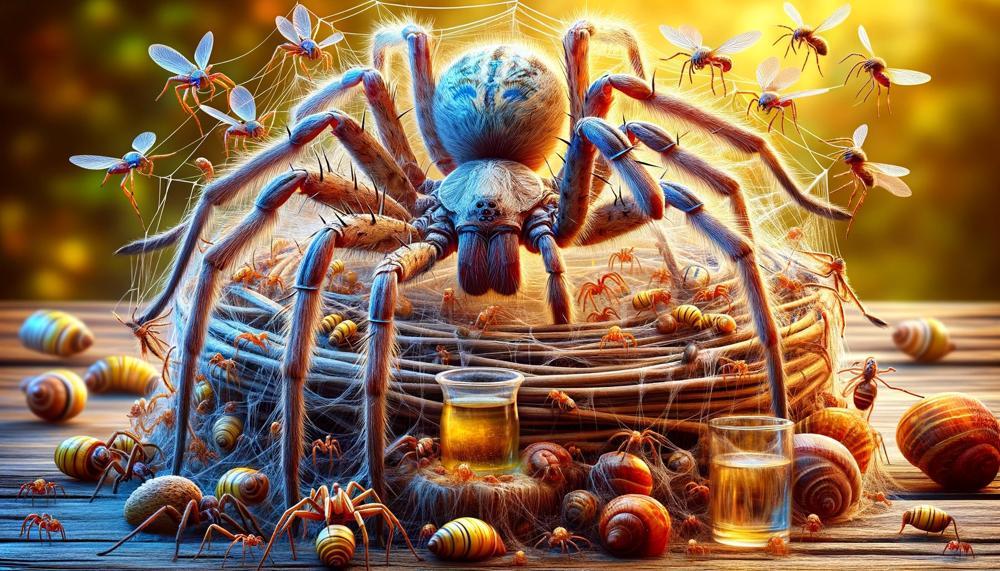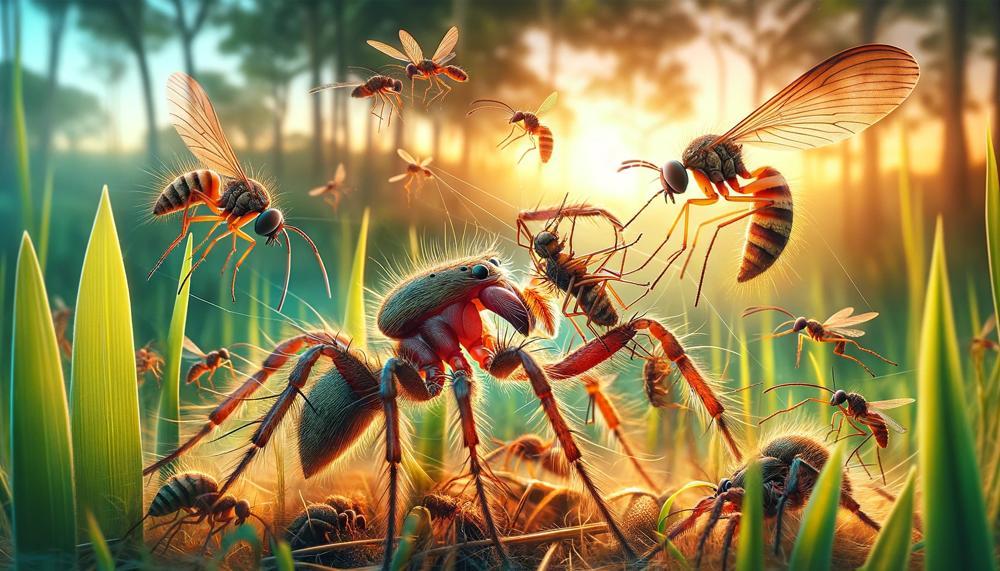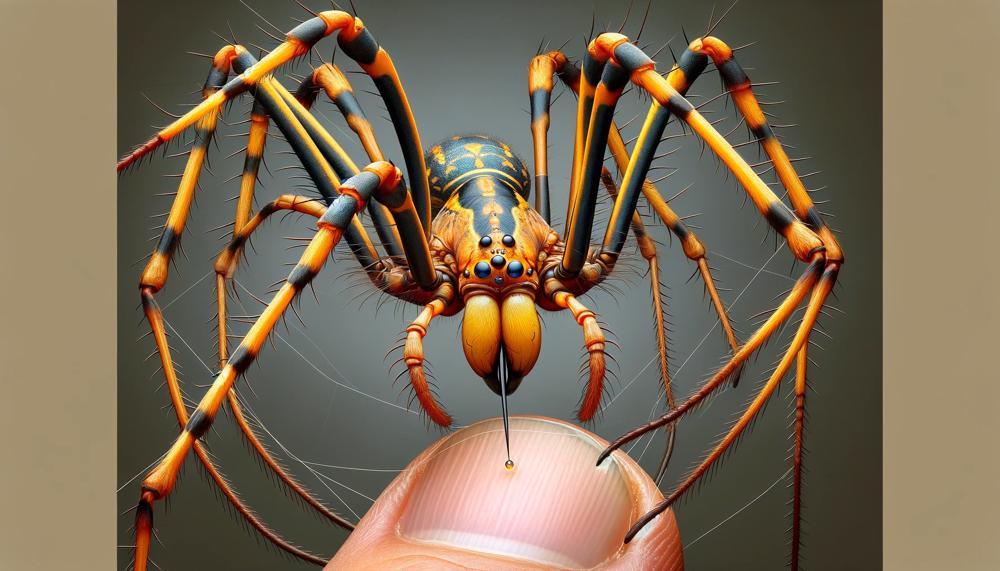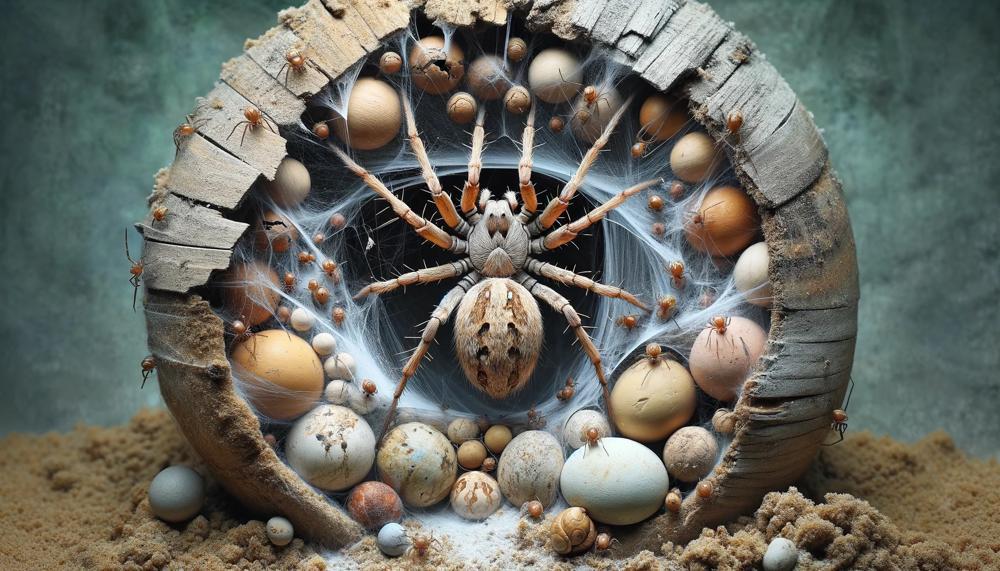Grass spiders, known for their funnel-shaped webs, are common in many outdoor spaces. While they play a crucial role in controlling pest populations, their presence can be unsettling for some.
Fortunately, managing these eight-legged visitors doesn’t require harsh chemicals or professional exterminators.
In this post, we’ll explore a range of natural solutions that are not only effective but also safe for you, your family, and the environment.
We’ll cover key strategies including:
- Habitat Modification: Learn how to make your garden less inviting to grass spiders by adjusting the landscape and gardening practices.
- Natural Predators: Discover how encouraging certain wildlife can help control the spider population naturally.
- Essential Oils and Natural Repellents: Get the scoop on which natural substances deter spiders and how to apply them effectively.
- Physical Removal: Tips on safely capturing and relocating these arachnids without harm.
Our goal is to provide you with a comprehensive guide that’s both easy to understand and implement. Whether you’re a gardening enthusiast or simply looking to enjoy your outdoor space without unwanted guests, this post will arm you with the knowledge you need to keep grass spiders at bay, naturally.
Let’s dive in.
Table of Contents
What Are Grass Spiders?
Grass Spiders, members of the genus *Agelenopsis*, are architects of the arachnid community, crafting intricate funnel webs across grassy knolls, gardens, and shrubs. Their preference for verdant spaces offers a strategic advantage, enabling them to ensnare unsuspecting insects with ease.
Distinctive Features of Grass Spiders:
- Spinnerets: Grass Spiders boast elongated spinnerets, giving the appearance of miniature tails, a rarity among their eight-legged kin.
- Web Design: Their web is a masterpiece of natural engineering, a horizontal sheet with a retreat funnel, acting as both a sanctuary and a trap.
- Cannibalistic Tendencies: When dusk falls, these spiders may turn on their own, displaying a darker side to their survival instincts.
- Diet: Versatile in their culinary pursuits, they feast on a variety of insects, maintaining the ecological balance.
Differences from Other Spiders
| Feature | Grass Spider | Other Spiders |
| Web Structure | Horizontal sheet with funnel retreat | Varies (orb, cobweb, no web) |
| Spinnerets | Long and tail-like | Shorter, less distinctive |
| Activity Period | Nocturnal hunters | Varies (diurnal/nocturnal) |
| Behaviour | Cannibalistic | Varies, not typically cannibalistic |
To deter these nimble weavers, regular mowing and tidiness in the garden are your best allies. Though they play a vital role in subduing pesky insects, their presence in large numbers might be unwelcome. They’re venomous, yet their fangs can’t cause harm to humans or pets, save for a rare nip that might result in minimal discomfort.
If grass spiders have overstayed their welcome, resist reaching for pesticides. Instead, prune your garden, clip the grass, and clear the clutter. Should you need reinforcements, pest control specialists are adept at evicting these uninvited guests with minimal fuss.
Remember, while their appearance may startle, grass spiders are the unsung heroes of your garden’s ecosystem, silently guarding against a myriad of insects.
What Do Grass Spiders Look Like?
Grass spiders, the masters of camouflage and craft in the garden’s understory, are a sight to behold if you’re keen enough to spot them. Let’s delve into the nitty-gritty of their appearance.
General Characteristics
Grass spiders, belonging to the genus *Agelenopsis*, are a tapestry of earthy hues. Their body length varies, with females measuring up to 20mm (0.78 inches) and males slightly smaller, embodying the subtle size-based dimorphism in the arachnid world.
Coloration and Markings
A glance at a grass spider reveals a canvas of yellow-brown or plain brown, with artistic stripes adorning their cephalothorax—a testament to their name. Two prominent, dark longitudinal bands sit beside the eyes, while the carapace is etched with soft, thin lines.
Unique Identifiers
| Head Region | Resembles wolf or hobo spiders but distinguished by two dark lines flanking the center and chevron patterns on the abdomen. |
| Web Structure | A horizontal sheet with a retreat funnel; non-sticky but equipped with tripwires for prey detection. |
| Behaviour | Cannibalistic tendencies are present but uncommon; nocturnal hunters with reflective eyes. |
Are Lawn Spiders The Same As Grass Spiders?
Yes, the terms ‘lawn spiders’ and ‘grass spiders’ often refer to the same creatures. These arachnids, known for their agility and funnel-shaped webs, are a common sight in gardens and lawns. They’re part of the Agelenidae family, which includes several genera commonly found in grassy areas.
Natural Methods to Get Rid of Lawn and Grass Spiders
Given that lawn spiders and grass spiders are essentially the same, natural methods to deter them generally apply to both. These methods highlight non-toxic ways to keep these spiders at bay, ensuring safety for humans, pets, and the environment.
| Method | Description | Effectiveness |
| Regular Lawn Maintenance | Trimming grass and removing debris disrupts the spiders’ habitat. | Highly Effective |
| Natural Predators | Encouraging birds or beneficial insects can reduce spider populations. | Varies |
| Essential Oils | Peppermint, tea tree, and eucalyptus oils can act as natural repellents. | Moderately Effective |
| Diatomaceous Earth | Food-grade diatomaceous earth can be sprinkled around the lawn to deter spiders. | Effective |
When dealing with these spiders, remember they play a role in controlling pests. They’re the unsung heroes in the background, gobbling up insects left and right. But if they’re turning your home into an eight-legged convention, these natural methods can send them packing without harsh chemicals.
Regular maintenance is the best bet, keeping things tidy and less inviting for our web-weaving pals.
Lawn Spider Identification
Quick Tips for Spotting Grass Spiders
- Look out for funnel-shaped webs in the grass; these are telltale signs of grass spiders’ presence.
- Observe the spider’s coloring; grass spiders typically sport brown or grey hues with noticeable stripes on their abdomens.
Identifying Features of Grass Spiders
| Web Structure | Funnel-shaped, non-sticky, using grass blades |
| Colour | Brown or grey with striped patterns on the abdomen |
| Behaviour | Quick, agile, often seen darting to the funnel part of their web when disturbed |
What You Should Know About Lawn Spiders
Grass spiders, mates, are as common as rain in Manchester, but they’re no bother. They’re not out to harm you, just managing the bugs in your turf. If it’s getting nippy out and you spot more inside, they’re just seeking some warmth.
No need for alarm, they’ll pop their clogs when the frost bites.
Keeping Spiders Off Your Turf
A tidy garden’s a less inviting spot for these critters. Keep your grass trimmed, and clear debris where spiders might fancy setting up shop.
If you’re keen on a spotless home, regular hoovering can keep any adventurous spiders from settling in. Fancy a less toxic approach outside? Opt for natural predators or a spot of diatomaceous earth instead of harsh chemicals.
When Spiders and Pooches Mix
If your furry mate’s had a run-in with a grass spider, keep a watchful eye. Chances are it’s all fine, but if Rover’s looking poorly, a quick trip to the vet wouldn’t go amiss.
Remember, not all webs are spider work. Fungi can masquerade as webs too, so give it a gander before going on a spider hunt. Keep the lawn dry to ward off these imposters.
How Do I Get Rid Of Spiders On My Lawn?
To effectively manage grass spiders on your lawn using natural methods, consider the following strategies:
Maintain a Tidy Lawn
Keep grass trimmed and remove excess plant debris where spiders may hide. Regularly rake leaves, mow the lawn, and prune shrubbery.

Natural Repellents
Certain plants and substances act as natural deterrents for spiders. Planting eucalyptus, lavender, or mint may help keep spiders at bay due to their strong scents.
Water Wisely
Avoid overwatering your lawn. Spiders seek out moist environments, so keeping the ground drier can discourage them from settling in.
Encourage Natural Predators
Birds and other insectivorous animals can help control spider populations. Install birdhouses or baths to attract these natural allies.
Essential Oils
Mix water with essential oils such as peppermint, tea tree, or citrus and spray around the lawn’s perimeter to repel spiders.
Diatomaceous Earth
Sprinkle diatomaceous earth around areas where spiders frequent. It’s a natural substance that can dehydrate and kill spiders upon contact.
Manual Removal
Regularly inspect your lawn and manually remove any webs or spiders you find.
Conclusion
In conclusion, managing grass spiders doesn’t have to involve chemicals or professional exterminators.
Our guide has highlighted natural, eco-friendly strategies to keep these arachnids at bay. By modifying their habitat through regular lawn maintenance, such as trimming grass and removing debris, you can make your yard less inviting to them.
Encouraging natural predators, applying essential oils, and using diatomaceous earth can also serve as effective deterrents. Physical removal, when necessary, should be done gently to preserve the delicate ecological balance these spiders contribute to.
With these tips, you can enjoy your outdoor space, knowing you’ve taken humane and environmentally considerate steps to maintain it.





